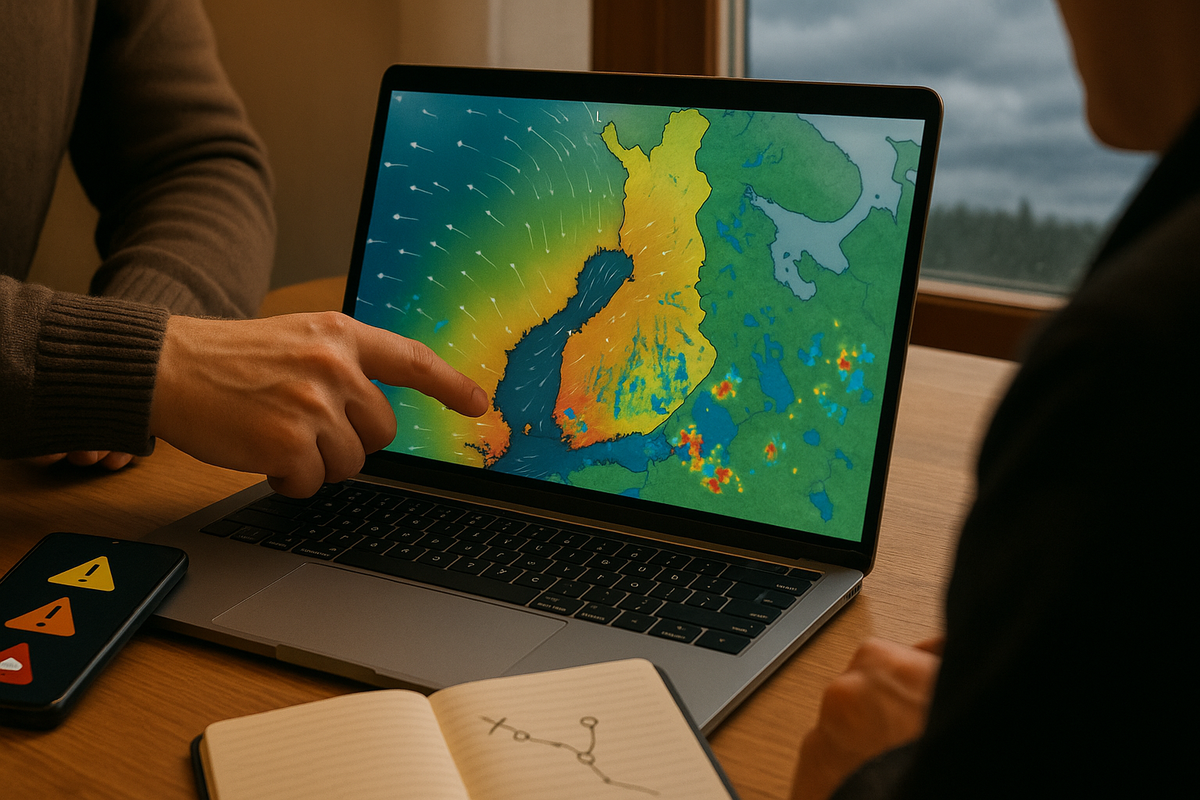🌦️ FMI forecasts and warnings: how to decide whether to go or not to go
Imagine: you've already read the general guide to weather and seasons in Finland, chosen your dates, and planned your routes. When you open FMI, you'll see layers, maps, wind arrows and coloured warning zones. So, I'm wondering what to do next: should I go to the seaside or have a coffee at home?
This article's all about how to take the FMI forecast and turn it into something you can use to make decisions today. We won't rewrite the service instructions, but we'll translate them into the language of travellers: If I want to go for a walk along the embankment, go kayaking or take a trip to Lapland, what do I need to think about and where should I draw the line?

What is FMI and why is it important for tourists?
FMI (Finnish Meteorological Institute) is not just another app with a sun and a cloud. It is the source on which the following are based:
● official warnings (wind, snow, waves, ice);
● forecasts for the sea, lakes, roads;
● information used by ferries, services and locals.
For weather in the spirit of "should I take an umbrella to Helsinki today," regular apps will do. But for things like:
● "Can I go SUPing on Lake Saimaa today?"
● "Is it worth going to the islands with the family in this wind?"
● "Is it safe to drive on the motorway to Lapland at night?"
it is the FMI that becomes the "voice of reason".
How the FMI forecast works: don't be afraid of the map
Most often, you will see a map of Finland with coloured spots and arrows (wind), plus a choice of layers: temperature, precipitation, wind, waves, warnings.
Mini "translator":
How to read FMI forecast layers
- Temperature: choose the hour you care about, note coastal vs inland difference.
- Wind: focus on speed (m/s) and gusts for sea, lakes and ridges.
- Precipitation: check intensity and duration, not only “rain / no rain”.
- Warnings: look at colour (yellow / orange / red) and type (wind, snow, ice, waves).
The trick is not to look 24 hours ahead, but to narrow down the question:
"Tomorrow from 10 a.m. to 5 p.m. on the lake is important to me" → go and look at the specific times and parameters that are critical for you.

Coloured warnings: yellow — not the end of the world, red — no joke
FMI uses colour-coded warning levels (similar to many countries): yellow, orange, red. This is not a "panic board" but a language of risk.
Simply put:
● Yellow — 'pay attention'. The weather may complicate your plans, especially on the water and on the roads.
● Orange — "may seriously interfere." For walks and light activities, this is already a reason to cancel/postpone.
● Red — "may be dangerous." This is a matter of public services, not "breathing sea air."
Important: the type of warning is no less important than the colour. Yellow for wind at sea is not at all the same as yellow for temperature.
Personal thresholds: turning the forecast into a "go/no-go"
The official level is good, but you need your own personal level. Wind of 8 m/s for an experienced kayaker and for a family with children are two different worlds.
Let's make a small matrix for real scenarios: the embankment, lake, trail, road.
This is just a template. If you are afraid of water, your threshold for SUP may be 3–4 m/s. If you are confident in winter, you will be more relaxed about light snow. The main thing is to set your numbers in advance, rather than coming up with them at the threshold of a stormy bay.

How to use FMI in stages: yesterday, today, now
To avoid getting stuck in endless scrolling, you can divide the forecast into three "rings":
Three-step FMI routine
- Day before: check general trend (fronts, storms, strong winds), choose main / backup plan.
- Morning: look at specific hours for your activity window, confirm or switch to plan B.
- Right before: quick check of latest radar / wind updates, adjust clothing and route.
In winter (especially in Lapland, which you can read about in a separate guide), this saves a lot of stress: it's one thing to know that "it will snow somewhere during the day," but it's another to see that the front will pass before lunchtime and simply postpone your trip.
Seas, lakes, trails, roads: a few typical pictures
So that FMI doesn't seem abstract, let's tie it to real situations.
The sea and archipelagos
You check the wind and wave forecast and sea warnings. If the wind is already in the yellow/orange zone and the waves are higher than you'd like, it's probably best to move your SUP/small boat and read up on the Baltic Sea by season at home, instead of arguing with the weather front.
Lake region
On lakes, it's often important to watch out for wind in the morning and thunderstorms in the afternoon. If it's calm and clear in the morning, but there are thunderstorms in the afternoon, get out on the water early and come back before the storm hits.
Lapland and trails
It's really important to be aware of wind and visibility when you're in the mountains or on the fells. Even when it's "normal" outside, with winds of 15 m/s and snowstorms, hiking to an open ridge can turn into a real survival mission. On the other hand, forest routes with the same forecast may be quite okay if there's not too much snow.
Roads and transport
Here, FMI fits perfectly with our text about weather and transport in Finland: warnings about ice, snowfall and wind directly indicate when it makes sense to postpone your trip until the afternoon, add an overnight stay or switch to a train.
How not to turn the forecast into a source of anxiety
The most common mistake is trying to find the perfect day by scrolling through the map endlessly. Finnish weather doesn't work that way.
A working strategy:
- Accept that there may not be a perfect day, and that's okay.
- Keep at least two scenarios in mind: active (trail, kayak, islands) and gentle (city, museum, café, short walk).
- Check the FMI and don't ask "will tomorrow be perfect", ask "which scenario makes more sense to include tomorrow".
This way, the forecast ceases to be an "assessment of the trip" and becomes a tool for making choices.
The FMI won't tell you if tomorrow will be "beautiful" — it'll show you where the wind, fronts, thunderstorms, snow and waves are. You'll have to add the beauty yourself: sometimes it's an early start on the trail before the rain, sometimes it's the decision to stay in a cabin with a view of the rain instead of being a hero on a kayak.
Let us know in the comments how you've found forecasting useful. Do you trust the FMI 100%? Have you ever been caught in an unexpected storm, or cancelled your plans for no reason? Do you have your own personal thresholds for wind, temperature or snow? If you could share your numbers and stories, that'd be great. The more real examples there are, the easier it'll be for the next reader to translate the maps and warnings into an understandable "go/no go" for their plans.
FAQ
FMI is the official source for Finland, relied upon by services, transport and local warnings. This does not mean that the forecast is never wrong, but this is where you get the most up-to-date maps, wind, precipitation and hazard levels by region.
It is usually realistic to plan 1–3 days ahead. Beyond that, the forecast is more about trends ("front in the middle of the week", "windy period") than specific hours. For hiking, skiing and water activities, it is better to make the final decision the evening before and on the morning of the activity.
For most people, a walk by the sea with winds up to 8 m/s will simply be "cool" with the right clothing. Anything higher than that makes kayaking and SUP a risky endeavour, and the embankment a place for a short walk rather than a long promenade with children.
Look at the wind map for a specific body of water, wind and thunderstorm warnings. If there is a warning for storms, strong winds or thunderstorms, and your wind threshold is exceeded, this is a good reason to postpone your trip. For family trips on lakes, a thunderstorm forecast alone is already a "no".
It won't give you a direct "sign from above," but warnings about snowfall, black ice and icy roads are a strong signal to reconsider your plans. If you see a combination of "heavy snow + frost + night travel" and ice warnings, that's when a train or daytime travel becomes a very good idea.
Not necessarily. You can adjust your plan: leave earlier, shorten your route, avoid high open areas, and return to shelter in time. FMI helps by showing the approximate time and area where a thunderstorm is most likely to occur.
No, that's a sure way to get anxious. Three checks are enough: the evening before (general plan), in the morning (confirm/change the scenario) and a quick check before leaving (wind/precipitation). If difficult weather is expected, you can check once during the day — and that's it.
Start simple: choose one activity (e.g., walking along the waterfront) and record a couple of trips in a row: what was the wind/rain like according to the FMI and how did you feel? After 2-3 times, you will have your own numbers: where it was okay and where it was "no more, please."
The official level is the same, but children get cold faster, tire more easily and are worse at assessing risks. Therefore, your personal thresholds for family activities are usually lower: less wind, shorter routes, more caution around water and ice.





0 comments
Log in to leave a comment